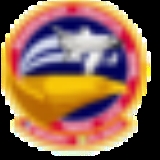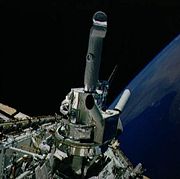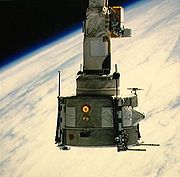
STS-51-F
Encyclopedia
STS-51-F was the nineteenth flight of NASA
's Space Shuttle program
, and the eighth flight of Space Shuttle Challenger
. It launched from Kennedy Space Center
, Florida
, on 29 July 1985, and landed just under eight days later on 6 August.
While STS-51-F's primary payload was the Spacelab
-2 laboratory module, the payload which received the most publicity was the Carbonated Beverage Dispenser Evaluation, which was an experiment in which both Coca-Cola
and Pepsi
tried to make their carbonated drinks available to astronauts.
(SSME) coolant valve caused the shutdown of all three main engines.
Challenger launched successfully on its second attempt at 29 July 1985, 17:00 EDT, after a delay of one hour and 37 minutes due to a problem with the table maintenance block update uplink.
Three minutes and 31 seconds into the ascent, one of the center engine's two high pressure fuel turbopump turbine discharge temperature sensors failed. Two minutes and 12 seconds later, the second sensor failed, causing the shutdown of the center engine. This was the only in-flight main engine failure of the shuttle program. Approximately 8 minutes into the flight, one of the same temperature sensors in the right engine failed, and the remaining right engine temperature sensor displayed readings near the redline for engine shutdown. Booster Systems Engineer Jenny M. Howard acted quickly to command the crew to inhibit any further automatic SSME shutdowns based on readings from the remaining sensors, preventing the potential shutdown of a second engine and a possible abort mode that may have resulted in the loss of the vehicle and crew.
The failed SSME resulted in an Abort To Orbit (ATO) trajectory, whereby the shuttle achieved a lower-than-planned orbital altitude.

 STS-51-F's primary payload was the laboratory module Spacelab
STS-51-F's primary payload was the laboratory module Spacelab
-2. A special part of the modular Spacelab system, the "igloo
", which was located at head of a three-pallet train, provided on-site support to instruments mounted on pallets. The main mission objective was to verify performance of Spacelab systems, determine the interface capability of the orbiter, and measure the environment created by the spacecraft. Experiments covered life sciences, plasma physics, astronomy
, high-energy astrophysics
, solar physics
, atmospheric physics
and technology research. Despite mission replanning necessitated by Challenger' s abort to orbit trajectory, the Spacelab mission was declared a success.
The flight marked the first time the ESA
Instrument Pointing System (IPS) was tested in orbit. This unique pointing instrument was designed with an accuracy of one arcsecond. Initially, some problems were experienced when it was commanded to track the Sun
, but a series of software fixes were made and the problem was corrected.
In addition, Tony England became the second amateur radio operator
to transmit from space
during the mission.
The Spacelab Infrared Telescope (IRT) was also flown on the mission. The IRT was a 15.2 cm aperture helium-cooled infrared
telescope, observing light between wavelengths of 1.7 to 118 μm. The experiment experienced some problems, such as heat emissions from the Shuttle corrupting data, but still returned useful astronomical data.
In a heavily-publicised marketing experiment, astronauts aboard STS-51-F enjoyed carbonated beverage
s from specially-designed cans provided by competitors
Coca-Cola
and Pepsi
.
, California
, on 6 August, 1985, at 12:45:26 pm PDT. Its rollout distance was 8569 feet (2,611.8 m). The mission had been extended by 17 orbits for additional payload activities due to the abort-to-orbit. The orbiter arrived back at Kennedy Space Center on 11 August 1985.
artist Skip Bradley. Space Shuttle Challenger
is depicted ascending toward the heavens in search of new knowledge in the field of solar and stellar astronomy, with its Spacelab 2 payload. The constellations Leo
and Orion
are shown in the positions they were in relative to the Sun during the flight. The nineteen stars indicate that the mission is the 19th shuttle flight.
NASA
The National Aeronautics and Space Administration is the agency of the United States government that is responsible for the nation's civilian space program and for aeronautics and aerospace research...
's Space Shuttle program
Space Shuttle program
NASA's Space Shuttle program, officially called Space Transportation System , was the United States government's manned launch vehicle program from 1981 to 2011...
, and the eighth flight of Space Shuttle Challenger
Space Shuttle Challenger
Space Shuttle Challenger was NASA's second Space Shuttle orbiter to be put into service, Columbia having been the first. The shuttle was built by Rockwell International's Space Transportation Systems Division in Downey, California...
. It launched from Kennedy Space Center
Kennedy Space Center
The John F. Kennedy Space Center is the NASA installation that has been the launch site for every United States human space flight since 1968. Although such flights are currently on hiatus, KSC continues to manage and operate unmanned rocket launch facilities for America's civilian space program...
, Florida
Florida
Florida is a state in the southeastern United States, located on the nation's Atlantic and Gulf coasts. It is bordered to the west by the Gulf of Mexico, to the north by Alabama and Georgia and to the east by the Atlantic Ocean. With a population of 18,801,310 as measured by the 2010 census, it...
, on 29 July 1985, and landed just under eight days later on 6 August.
While STS-51-F's primary payload was the Spacelab
Spacelab
Spacelab was a reusable laboratory used on certain spaceflights flown by the Space Shuttle. The laboratory consisted of multiple components, including a pressurized module, an unpressurized carrier and other related hardware housed in the Shuttle's cargo bay...
-2 laboratory module, the payload which received the most publicity was the Carbonated Beverage Dispenser Evaluation, which was an experiment in which both Coca-Cola
Coca-Cola
Coca-Cola is a carbonated soft drink sold in stores, restaurants, and vending machines in more than 200 countries. It is produced by The Coca-Cola Company of Atlanta, Georgia, and is often referred to simply as Coke...
and Pepsi
Pepsi
Pepsi is a carbonated soft drink that is produced and manufactured by PepsiCo...
tried to make their carbonated drinks available to astronauts.
Crew
Backup crew
Mission parameters
- MassMassMass can be defined as a quantitive measure of the resistance an object has to change in its velocity.In physics, mass commonly refers to any of the following three properties of matter, which have been shown experimentally to be equivalent:...
:- Orbiter Liftoff: 252855 lbs
- Orbiter Landing: 216735 lbs
- Payload: 35955 lbs
- PerigeePerigeePerigee is the point at which an object makes its closest approach to the Earth.. Often the term is used in a broader sense to define the point in an orbit where the orbiting body is closest to the body it orbits. The opposite is the apogee, the farthest or highest point.The Greek prefix "peri"...
: 193.9 miles (312.1 km) - Apogee: 199.5 miles (321.1 km)
- InclinationInclinationInclination in general is the angle between a reference plane and another plane or axis of direction.-Orbits:The inclination is one of the six orbital parameters describing the shape and orientation of a celestial orbit...
: 49.5° - PeriodOrbital periodThe orbital period is the time taken for a given object to make one complete orbit about another object.When mentioned without further qualification in astronomy this refers to the sidereal period of an astronomical object, which is calculated with respect to the stars.There are several kinds of...
: 90.9 min
Launch
STS-51-F's first launch attempt on 12 July 1985 was halted with the countdown at T-3 seconds after main engine ignition, when a malfunction of the number two Space Shuttle Main EngineSpace Shuttle main engine
The RS-25, otherwise known as the Space Shuttle Main Engine , is a reusable liquid-fuel rocket engine built by Pratt & Whitney Rocketdyne for the Space Shuttle, running on liquid hydrogen and oxygen. Each Space Shuttle was propelled by three SSMEs mated to one powerhead...
(SSME) coolant valve caused the shutdown of all three main engines.
Challenger launched successfully on its second attempt at 29 July 1985, 17:00 EDT, after a delay of one hour and 37 minutes due to a problem with the table maintenance block update uplink.
Three minutes and 31 seconds into the ascent, one of the center engine's two high pressure fuel turbopump turbine discharge temperature sensors failed. Two minutes and 12 seconds later, the second sensor failed, causing the shutdown of the center engine. This was the only in-flight main engine failure of the shuttle program. Approximately 8 minutes into the flight, one of the same temperature sensors in the right engine failed, and the remaining right engine temperature sensor displayed readings near the redline for engine shutdown. Booster Systems Engineer Jenny M. Howard acted quickly to command the crew to inhibit any further automatic SSME shutdowns based on readings from the remaining sensors, preventing the potential shutdown of a second engine and a possible abort mode that may have resulted in the loss of the vehicle and crew.
The failed SSME resulted in an Abort To Orbit (ATO) trajectory, whereby the shuttle achieved a lower-than-planned orbital altitude.
Mission summary


Spacelab
Spacelab was a reusable laboratory used on certain spaceflights flown by the Space Shuttle. The laboratory consisted of multiple components, including a pressurized module, an unpressurized carrier and other related hardware housed in the Shuttle's cargo bay...
-2. A special part of the modular Spacelab system, the "igloo
Igloo
An igloo or snowhouse is a type of shelter built of snow, originally built by the Inuit....
", which was located at head of a three-pallet train, provided on-site support to instruments mounted on pallets. The main mission objective was to verify performance of Spacelab systems, determine the interface capability of the orbiter, and measure the environment created by the spacecraft. Experiments covered life sciences, plasma physics, astronomy
Astronomy
Astronomy is a natural science that deals with the study of celestial objects and phenomena that originate outside the atmosphere of Earth...
, high-energy astrophysics
Astrophysics
Astrophysics is the branch of astronomy that deals with the physics of the universe, including the physical properties of celestial objects, as well as their interactions and behavior...
, solar physics
Solar physics
For the physics journal, see Solar Physics Solar physics is the study of our Sun. It is a branch of astrophysics that specializes in exploiting and explaining the detailed measurements that are possible only for our closest star...
, atmospheric physics
Atmospheric physics
Atmospheric physics is the application of physics to the study of the atmosphere. Atmospheric physicists attempt to model Earth's atmosphere and the atmospheres of the other planets using fluid flow equations, chemical models, radiation balancing, and energy transfer processes in the atmosphere...
and technology research. Despite mission replanning necessitated by Challenger
The flight marked the first time the ESA
European Space Agency
The European Space Agency , established in 1975, is an intergovernmental organisation dedicated to the exploration of space, currently with 18 member states...
Instrument Pointing System (IPS) was tested in orbit. This unique pointing instrument was designed with an accuracy of one arcsecond. Initially, some problems were experienced when it was commanded to track the Sun
Sun
The Sun is the star at the center of the Solar System. It is almost perfectly spherical and consists of hot plasma interwoven with magnetic fields...
, but a series of software fixes were made and the problem was corrected.
In addition, Tony England became the second amateur radio operator
Amateur radio operator
An amateur radio operator is an individual who typically uses equipment at an amateur radio station to engage in two-way personal communications with other similar individuals on radio frequencies assigned to the amateur radio service. Amateur radio operators have been granted an amateur radio...
to transmit from space
Shuttle Amateur Radio Experiment
The Shuttle Amateur Radio Experiment , later called the Space Amateur Radio Experiment, was a program that promoted and supported the use of amateur radio by astronauts in low earth orbit aboard the United States Space Shuttle to communicate with other amateur radio stations around the world...
during the mission.
The Spacelab Infrared Telescope (IRT) was also flown on the mission. The IRT was a 15.2 cm aperture helium-cooled infrared
Infrared
Infrared light is electromagnetic radiation with a wavelength longer than that of visible light, measured from the nominal edge of visible red light at 0.74 micrometres , and extending conventionally to 300 µm...
telescope, observing light between wavelengths of 1.7 to 118 μm. The experiment experienced some problems, such as heat emissions from the Shuttle corrupting data, but still returned useful astronomical data.
In a heavily-publicised marketing experiment, astronauts aboard STS-51-F enjoyed carbonated beverage
Soft drink
A soft drink is a non-alcoholic beverage that typically contains water , a sweetener, and a flavoring agent...
s from specially-designed cans provided by competitors
Cola wars
The Cola Wars are a campaign of mutually-targeted television advertisements and marketing campaigns since the 1980s between soft drink manufacturers Coca-Cola Company and PepsiCo Incorporated.- Competition :...
Coca-Cola
Coca-Cola
Coca-Cola is a carbonated soft drink sold in stores, restaurants, and vending machines in more than 200 countries. It is produced by The Coca-Cola Company of Atlanta, Georgia, and is often referred to simply as Coke...
and Pepsi
Pepsi
Pepsi is a carbonated soft drink that is produced and manufactured by PepsiCo...
.
Landing
Challenger landed at Edwards Air Force BaseEdwards Air Force Base
Edwards Air Force Base is a United States Air Force base located on the border of Kern County, Los Angeles County, and San Bernardino County, California, in the Antelope Valley. It is southwest of the central business district of North Edwards, California and due east of Rosamond.It is named in...
, California
California
California is a state located on the West Coast of the United States. It is by far the most populous U.S. state, and the third-largest by land area...
, on 6 August, 1985, at 12:45:26 pm PDT. Its rollout distance was 8569 feet (2,611.8 m). The mission had been extended by 17 orbits for additional payload activities due to the abort-to-orbit. The orbiter arrived back at Kennedy Space Center on 11 August 1985.
Mission insignia
The mission insignia was designed by HoustonHouston, Texas
Houston is the fourth-largest city in the United States, and the largest city in the state of Texas. According to the 2010 U.S. Census, the city had a population of 2.1 million people within an area of . Houston is the seat of Harris County and the economic center of , which is the ...
artist Skip Bradley. Space Shuttle Challenger
Space Shuttle Challenger
Space Shuttle Challenger was NASA's second Space Shuttle orbiter to be put into service, Columbia having been the first. The shuttle was built by Rockwell International's Space Transportation Systems Division in Downey, California...
is depicted ascending toward the heavens in search of new knowledge in the field of solar and stellar astronomy, with its Spacelab 2 payload. The constellations Leo
Leo (constellation)
Leo is one of the constellations of the zodiac. Its name is Latin for lion. Its symbol is . Leo lies between dim Cancer to the west and Virgo to the east.-Stars:...
and Orion
Orion (constellation)
Orion, often referred to as The Hunter, is a prominent constellation located on the celestial equator and visible throughout the world. It is one of the most conspicuous, and most recognizable constellations in the night sky...
are shown in the positions they were in relative to the Sun during the flight. The nineteen stars indicate that the mission is the 19th shuttle flight.
See also
- Space explorationSpace explorationSpace exploration is the use of space technology to explore outer space. Physical exploration of space is conducted both by human spaceflights and by robotic spacecraft....
- Space Shuttle programSpace Shuttle programNASA's Space Shuttle program, officially called Space Transportation System , was the United States government's manned launch vehicle program from 1981 to 2011...
- Space Shuttle ChallengerSpace Shuttle ChallengerSpace Shuttle Challenger was NASA's second Space Shuttle orbiter to be put into service, Columbia having been the first. The shuttle was built by Rockwell International's Space Transportation Systems Division in Downey, California...
- Space Shuttle Challenger disasterSpace Shuttle Challenger disasterThe Space Shuttle Challenger disaster occurred on January 28, 1986, when Space Shuttle Challenger broke apart 73 seconds into its flight, leading to the deaths of its seven crew members. The spacecraft disintegrated over the Atlantic Ocean, off the coast of central Florida at 11:38 am EST...
- List of space shuttle missions
- List of human spaceflights chronologically

